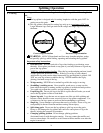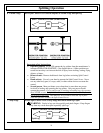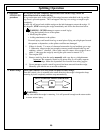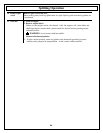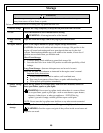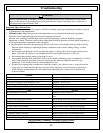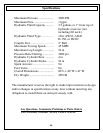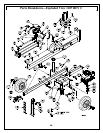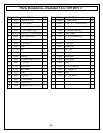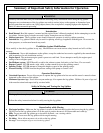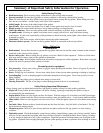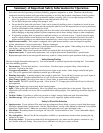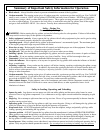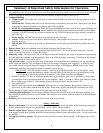
Summary of Important Safety Information for Operation
35
must NEVER actuate the Split Control Lever until the assistant and all bystanders are at least 10 feet away. NEVER
allow an assistant to hold the log in place while the operator actuates the Split Control Lever.
Loading/Unloading
Unsplit log pile. Do not pile logs to be split in a place that will make you reach across the log splitter in order to
load them.
Hold bark side. Hold the bark side of logs when loading or positioning, never the ends. Never place your hands
or any part of your body between a log and any part of the log splitter.
NOTE for vertical position loading: Place the log on the endplate and turn it until it leans against the beam and
is stable. If the log is too big or oddly shaped, stabilize the log with wooden shims between the log and endplate
or ground. DO NOT use your leg or knee to stabilize the log. NEVER stabilize the log by placing your hand on
top of the log.
Wedge moving. NEVER load or unload logs while the wedge is moving.
Cracks. Cracks in logs can close quickly and pinch fingers. Keep fingers away from any cracks that open in
partially split logs.
Split log pile. Move each log away from log splitter after it is split. Split logs left near the log splitter are a trip
hazard.
Remove hands. Remove both hands from log before activating Split Control Lever.
Hand activate. Use only your hand to operate the Split Control Lever. Never use any other body part, or a rope,
cable, or other remote device to actuate the control.
Returning wedge. Once the control valve is actuated in the return direction, the wedge is designed to keep returning
by itself completely and then stop automatically. Stay clear while the wedge is returning. It is still powerful enough
on the return stroke to cause serious injury.
Log stuck on wedge. A log can become stuck to the wedge if the wedge becomes embedded in the log and the log
doesn’t split and separate. This can happen if the log is too stringy or tough to split completely. A stuck log will
move back with the wedge on the initial attempt to retract the wedge. If this happens, STOP retracting the wedge
immediately and follow the directions below to manually remove the log:
IMPORTANT: NEVER attempt to remove a stuck log by using the hydraulic force of the splitter, or by
modifying or adding attachments to splitter. Personal injury could result from log or metal pieces flying
out at high speed toward the operator or bystanders, or the splitter could become damaged.
1. If there is already 1” or more of clearance between the log and endplate, go to step 2. Otherwise, retract wedge
just enough to remove pressure between the log and endplate – about 1” clearance. (Move split control to return,
allow wedge to move about 1”, then stop the wedge by moving the split control to neutral “N”.)
2. Turn engine OFF.
3. Remove stuck log from the wedge manually with a pry bar or a sledgehammer. Be extremely careful, as log
pieces may fly off as they separate from the wedge. Wear safety goggles and make sure bystanders are clear.
Do not attempt to resplit a stuck log once it has been removed from the wedge.
Changing splitting position. Do not change splitting positions (horizontal/vertical) with the engine running. You
may contact the muffler and receive serious burns. Be careful to avoid contact with hot muffler even after the engine
is turned off.
Refueling. Never refuel the engine until it has cooled at least two minutes.
Safety – After use
Return to horizontal. If in the vertical position, turn off engine and return log splitter to the horizontal position for
greater stability and to prepare for transportation. Avoid contact with hot muffler
Remove engine debris. Debris on a hot engine can be a fire hazard. With the engine off, clean debris and chaff
from engine cylinder head, cylinder head fins, blower housing rotating screen, and muffler areas. Avoid contact with
hot muffler.
Let engine cool before storing. Let engine cool for at least five minutes before storing. A hot engine can be a fire
hazard.



